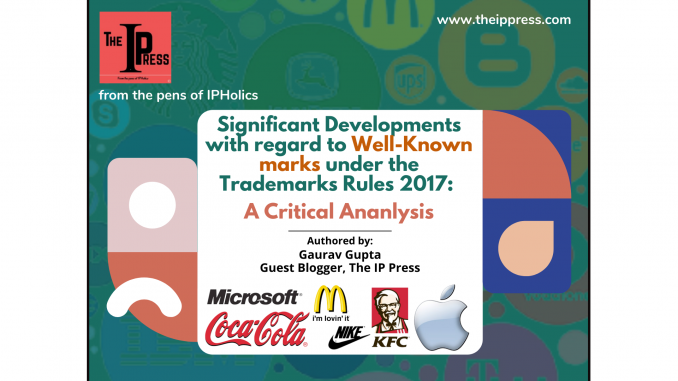
Introduction:
The Introduction of the Trademarks act brought in the concept of ‘well-known marks’[i] in India and defined protection criteria for the same. Later after noticing the drawbacks in the set guidelines, an initiative was taken by the government for drafting a revised set of rules to help ease of registration of trademarks and non-Conventional marks[ii] in India. With respect to the suggestions and objections of experts, the government came up with the Trademarks Rules 2017[iii] and replaced the Trademarks Rules 2002[iv]. To establish a process of registering well known, a new provision in the amendment of the Trademarks Rules 2017 was introduced. Further, the proposed amendment related to well-known marks had various loopholes in it, because of which the guidelines for registering well-known marks faced big controversies and criticism. The new rule was challenged on the grounds of its constitutional validity, giving unlimited arbitrary power to the registrar and lack of proper definition of nationwide acceptable criteria for considering a mark as a well-known mark.
What are Well-Known Marks:
As defined under Section 2 (1) (zg) of The Trademarks Act, 1999[v], “a marks which has become so to the substantial segment of the public which uses such goods or receives….….”. according to which the goodwill and reputation of a well-known marks are protected among all the categories of goods and services across the nation. If a trademark is declared as ‘well-known’, by any court or Registrar of the Trademarks, then any trademarks which is similar or identical to the ‘well-known’ trademarks cannot be registered across all classes of goods and services. For example, ‘Nestle’ has been declared a well-known trademark by Delhi High Court in 2013[vi], according to which only Societe des produits Nestle S.A can register ‘Nestle’ in any class they want to sell goods or services in any industry.
Newly introduced ‘Rule-124’ for Well-Known Marks:
Until Trademarks Rules, 2017 were introduced, a mark was categorized as well-known marks only if the registrar or the courts says so during the proceedings of Opposition, rectification, or Infringement making it very difficult for the companies in India to register their marks as Well-Known Marks. So, the necessary change brought in Indian Legislations for Well-Known marks was:
- Introduction of Rule-124 in Trademarks Rule, 2017:
According to the New Rule-124 of Trademarks Rules, 2017[vii], the new guidelines to recognize well known marks were established. The guidelines help the owner of the Trademarks to get their trademarks registered as well-known marks and do not have to wait for legal proceedings. The rule allows enlisting of trademarks as a well-known mark with the Registrar supported by evidence and fees of INR 1 lakh as is mentioned in entry-18 of Schedule-1[viii]. If a Trademarks is declared a well-known mark, then it is capable of being published in the journal.
Now the concern was what about “The marks declared as Well-Known marks before the introduction of Trademarks Rules, 2017,”
Regarding this, the Controller General of Patents, Design, and Trademarks issued a public notice[ix] stating that “the guidelines of Rule-124 says that list of documents shall be attached for applying for registration of Well-Known marks, and a copy of the judgment of any court or Registrar of trademarks needs to be produced along with the application wherein the trademarks is determined to be a well-known Trade Marks”. Hence, Rule-124 also caters to those marks which were already declared as Well-Known marks even before the introduction of Trademarks rules, 2017.
The Drawback of the newly introduced Rule-124: –
- Constitutional Validity of Rule-124:
After the Introduced changes a controversy arose on the constitutional validity of Rule-124 as the Trademarks Rules,2017 is a delegated legislation so it is supposed to be legitimate with respect to its parent statute i.e., Trademarks Act, 1999[x]. According to the Trademarks act 1999, the power to make a new procedure to register well-known marks is not given to the central government. Also, Section 157[xi] which defines central government’s rule-making power under the Trade Marks Act, 1999 allows the government to introduce rules for “any other matter which is required to be addressed or is prescribed to the government” is also silent about Well-known marks.
But the new Rule-124 establishes a new procedure which is not considered as adversarial proceeding to register Well-known marks. This new procedure conflicts with Section-11[xii] of the trademarks act, 1999, which establishes the adversarial procedure for registration of the well-known marks. Rule-124 permits registration of a well-known trademarks by simply filling an application to the registry, whereas, the procedure defined by Section-11 requires a proceeding of opposition, infringement, or rectification to determine the authenticity of marks being Well-known.
- No Limitation on the arbitrary power of Registrar:
This new legislation gives immense powers to the Trademarks Registry, where the case of Registrar ND Kasturi’s[xiii] Arrest had already proven the existence of corruption in the body. The new legislation will increase the possibility of abuse of power of registrar in registration of a well-known marks as it empowers the registrar to remove well-known marks from the list if a mark was added erroneously, also, now it is completely upon the discretion of the registrar to register a mark as a well-known mark or not as Section-11 clearly defines that for determining a mark as a well-known mark the registrar shall not require the following condition:
- That the mark is used in India
- The mark is registered
- Application for registration is filled
- The mark is declared well-known outside the jurisdiction of India
- The mark is well known in India
- Lack of proper guidelines for Well-known marks
The question of ‘whether a registered well-known mark’s protection is restricted to the class of goods and services it is registered for’ is not clear in the Trademarks Rule, 2017. As no option for putting a restriction or identification of such application is specified. Also, no guidelines are there to help the trademarks registry decide, what is the criteria of the appropriate use of the mark to determine a mark as well known. The Judiciary have time to time faced such problems in various cases such as in the case of Microsoft Corporation v Kurapati Venkata Jagdeesh Babu [xiv], where the court observed the lack of proper guidelines in the law, which resulted in such a situation where it was difficult for the company to register the mark ‘Microsoft’ as a Well-known and eventually keeping the company away from enjoying the benefits of a well-known mark and hence, their mark was being infringed. In all such cases it comes at the gates of the Judiciary to overcome such drawbacks and help in establishing a proper system, which in itself is a very lengthy process, eventually making the process of registration of trademark as a Well-known Mark, even more complex.
Propositions:
To overcome such drawbacks on the newly introduced Rule-124 in Trademarks Rules, 2017 I propose the following suggestion to be considered namely:
- New Legislations should be introduced which gives constitutional support to Rule-124 and establishes restriction or keeps a check on the arbitrary power of the registrar and further establishes guidelines for registration of the well-known marks, by setting up a criterion:
- That a company should have a minimum amount (say INR 500 crores) as their yearly turnover for more than 5 consecutive years, to be registered as a well-known mark;
- Proving that why only their marks should be considered as a well-known mark if other marks which are similar or identical to the applicant’s marks are also registered;
- Proving with stats and facts about their marks gaining secondary significance;
- Properly defining Scope of protection of well-known marks that can it be protected in all the classes or is the protection.
- In consideration of the provisions of Section 11, the Registrar has the liberty to invite objections before declaring the marks to be well known, for the above purpose, it should be mandated to the owner of the trademarks to publish an advertisement in a National and a local newspaper (as being followed in Dubai and China) declaring his/ her application for being registered as well-known marks has been accepted by the said registrar, now if anyone has any objection regarding such registration can raise their issues Infront of the registrar with valid documents and necessary details claiming their notion with a period of three (3) months, if no such objections are raised within the stipulated period, then the proposed marks is free for being registered as Well-Known marks in the Trademarks Journal.
Conclusion:
Although the new Rule brought in Trademarks Rule, 2017 is a good initiative leading into beneficial steps towards the development of Trademarks Registration system in this signifies the importance and the thrust given by the Government of India in IP sector and protection of IP laws in India making them more stringent and vaster in scope. The introduction of Trademarks Rules,2017, will prove out to be the beneficial in long run and will make the trademarks registration system in India more efficient, progressive, and user-friendly. The said changes will promote foreign companies to protect their Trademarks in India. Although the new rules lack proper planning and ignore and are silent on some factors, there is always a scope of improvement, by bringing necessary changes and keeping in mind important points of loopholes in the new rules, legislative changes will make the Trademarks Registration system in India stronger.
[i] Sonal Sodhani, All You Need To Know About “Well-Known Trademarks”, (July 29, 2021, 1:00 PM), https://www.mondaq.com/india/trademark/808148/all-you-need-to-know-about-well-known-trademarks
[ii] Diganth Raj Sehgal, Non-conventional trademarks and the procedural requirements for their registration, (July 29, 2021, 1:00 PM), https://blog.ipleaders.in/non-conventional-trademarks-procedural-requirements-registration/
[iii] Trademarks Rules 2017
[iv] Trademarks Rules 2002
[v] Trademarks Act, 1999, Section 2 (1) (zg)
[vi] Nestle India limited vs. Mood hospitality private limited, [2010 (42) PTC 514 (Del.) (DB)]
[vii] Trademarks Rules, 2017, Rule-124.
[viii] Trade Mark Rules 2017, Schedule-1, Entry-18
[ix] IPIndia, Public Notice, https://ipindia.gov.in/writereaddata/Portal/News/681_1_Public_Notice_dated_4-5-2020.pdf
[x] Trademarks Act, 1999
[xi] Trademarks Act, 1999, Section 157.
[xii] Trademarks Act, 1999, Section 11.
[xiii] Shamnad Basheer, CBI Raids Trademark Registrar’s House, (July 29, 2021, 1:00 PM), https://spicyip.com/2011/03/breaking-news-cbi-raids-trademark.html
[xiv] Microsoft Corporation v Kurapati Venkata Jagdeesh Babu, [CS(OS) No. 2163 of 2010 & I.A. No. 14225 of 2010]

Gaurav Gupta
Author
Greetings Everyone, Myself Gaurav Gupta, I am a 4th Year Law student, pursuing B.B.A LL.B(H) from Amity Law School, Noida, I have expertise in Intellectual Property Law and Corporate Law. I am passionate about learning new skills and exploring various aspects of Intellectual Property and Corporate Law.
Leave a Reply